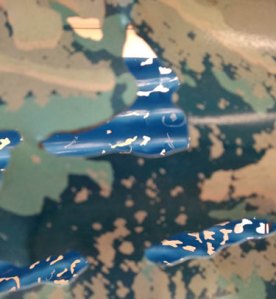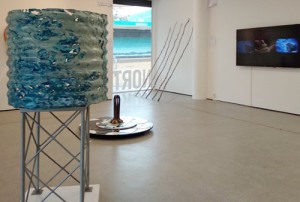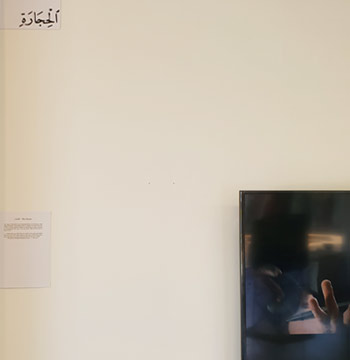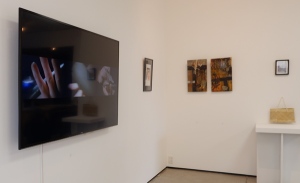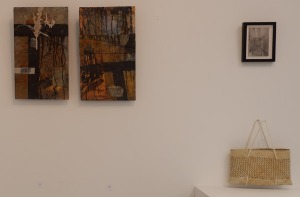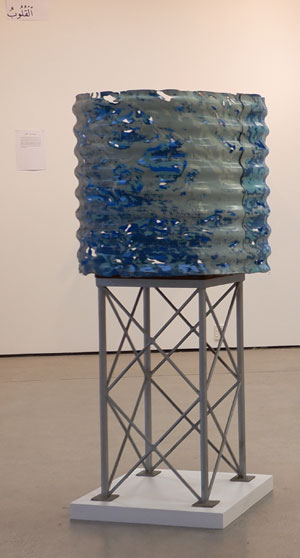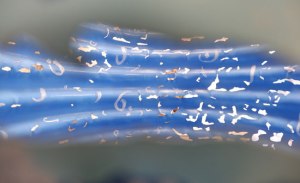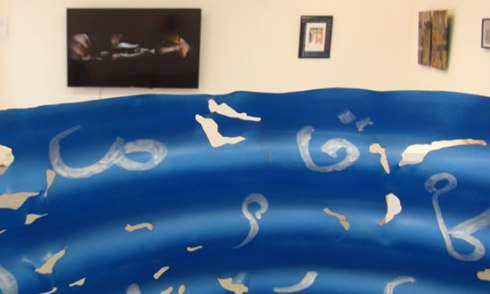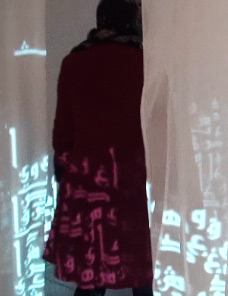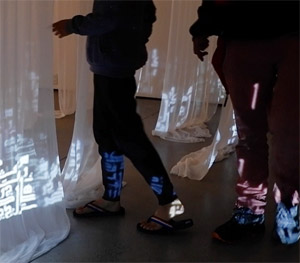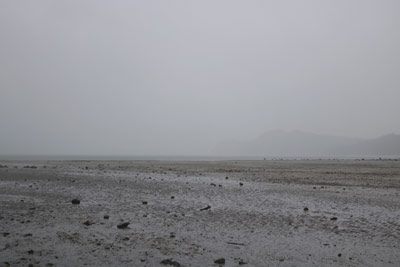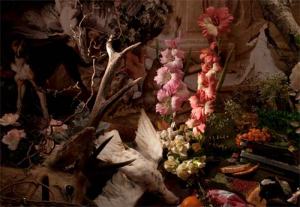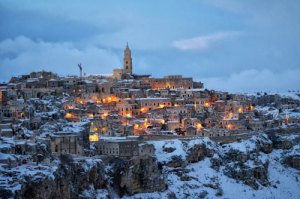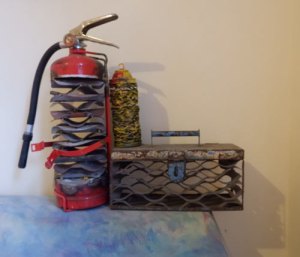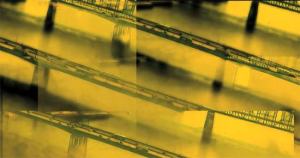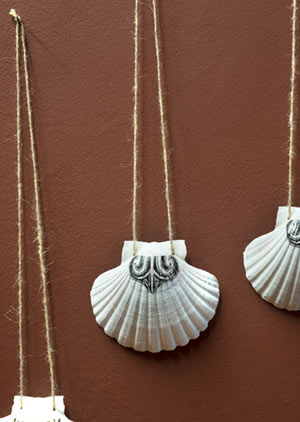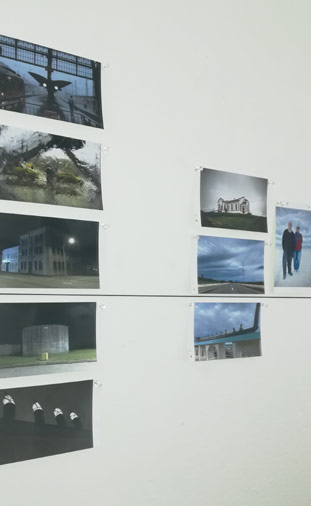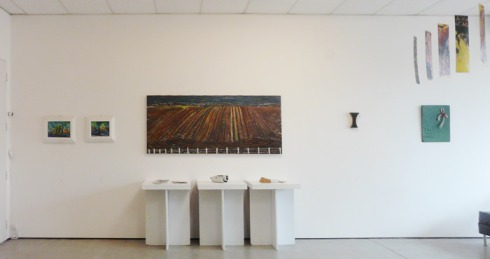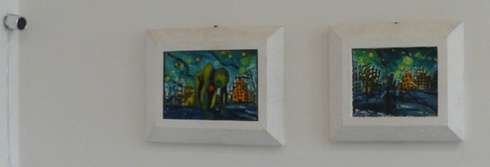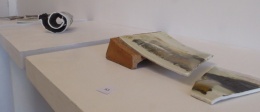Artists in Aotearoa | New Zealand are kaitiaki (stewards) for artists
in countries more stricken by COVID-19
Aodhán Floyd | April Shin | Ashleigh Taupaki | Bev Goodwin | Brenda Liddiard
Cathy Carter | Chiara Rubino | Emma Papadopoulos | Jessy Rahman | Jumaadi
Lipika Sen | Lissy and Rudi Robinson-Cole | Lloyd Lawrence | Michelle Mayn
Naomi Roche | Narjis Mirza | Martin Wohlwend | Masud Olufani
Nawruz Paguidopon | Prabhjyot Majithia | Phil Dadson
Pietertje van Splunter Robert Hamilton | Sen McGlinn | Shaeron Caton Rose
Sonja van Kerkhoff | Ursula Christel | Xiaojie Zheng | Yllwbro

Detail – Metamorfosi, 2021, Chiara Rubino (Matera, Italy) and Cathy Carter (Auckland, NZ)
Archival pigment ink photographic print on Hahnemuhle photo rag 306gsm. 140 x 90 cm.
Two more works in the main gallery. More photos on artsdiary.co.nz
Left of doorway: Planetscape by Lloyd Lawrence (NYC, USA) and Sonja van Kerkhoff,
The Shaman and the Healing Tree (with mirror) by Jessy Rahman (NL) and Sonja van Kerkhoff.
Metro Manila, photo-print by Nawruz Paguidopon
Above: A Paradox of Place by Sonja van Kerkhoff. Acrylic on wood, 61 x 84 cm. Wood from the Netherlands with a view of Matariki (The Seven Sisters constellation) as above Aotearoa.
Earthscape I, II, III, by Lloyd Lawrence (NYC, USA) with Sonja van Kerkhoff, 3 laser prints on transparency. Limited Edition of 5. Approx 29 x 20 cm. Lloyd emailed photos of his colleges made out of Art Catalogues, giving Sonja freedom to print them in any manner.
Diary of Dust, 2016, Animated, Produced, and Directed by Dave Brown. 2 min 53 sec animation featuring Jumaadi’s, 2014, 7 metre drawing made during a residency at the Halsey Institute of Contemporary Art, College of Charleston School of the Arts, South Carolina, U.S.A. The Halsey Institute commissioned San Francisco-based filmmaker Dave Brown to make this video animation with original gamelan music, composed and performed by Nathan Koc.
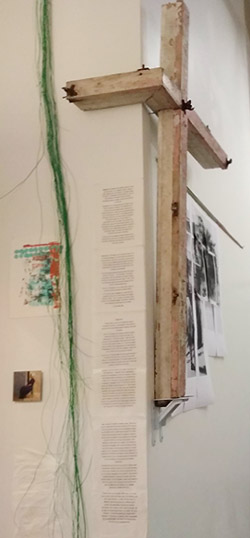
Philoxenia 4, 2021, by Emma Papadopoulos. Acrylic on paper, 24 x 30 cm
Josephine’s Mother by Sonja van Kerkhoff, photo-print, 10 x 10 cm, crushed paper – Naomi Roche.
Sen printed out a drawing onto multiple layers, and assembled these under a wooden construction. Drawing by Aodhán Floyd of his father standing in the UN buffer zone in Cyprus.
“‘Deposition’ is an indirect portrait of my father, Anton Floyd, a poet and translator. He is standing in his home city, at a barricaded border crossing on the southern side of the ‘Green Line’ that divides the island and runs through the capital.” – Aodhán Floyd, Cork, Ireland
Texts incorporate Emma’s thoughts (her father is a Cypriot), Aodhan’s reflections, Sonja’s 2009 performance across the Nicosia Green Line, and Sen’s reflections.
The Green Line, 2021 by Bev Goodwin. Recycled telephone wire.
Philoxenia, 2021. Arrangements by Emma Papadopoulos (Greece), Naomi Roche and Sonja van Kerkhoff
“Philoxenia of Greek origin literally means ‘friend to a stranger’. Philoxenia pertains to taking care of, looking after, being hospitable. My tavern chairs, my cultural reference to Greek hospitality, are currently empty due to lockdown.”
– Emma Papadopoulos, Athens, Greece.

Detail of the main gallery – works by Aodhán Floyd (Cork, Ireland), April Shin, Brenda Liddiard, Jumaadi (Australia/Indonesia), Emma Papadopoulos (greece), Masud Olufani (USA) and Ursula Christel, Nawruz Paguidopon (The Philippines), Phil Dadson, Pietertje van Splunter (The Netherlands), Shaeron Caton Rose (UK), and Xiaojie Zheng (SF, USA/Wenzhou, China)

selfies from the other side – Aodhán Floyd, Chiara Rubino, Emma Papadopoulos, Jessy Rahman, Jumaadi, Lloyd Lawrence, Martin Wohlwend, Masud Olufani, Nawruz Paguidopon, Pietertje van Splunter, Robert Hamilton, Shaeron Caton Rose and Xiaojie Zheng
Details about each selfie is here: sonjavank.com/takecare/
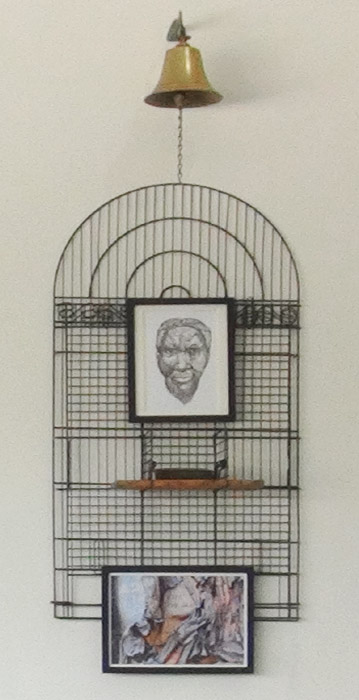
The Wealth of the Nation, 2021, by Masud Olufani (Atalant, USA)
and Ursula Christel (Warkworth, NZ).
4-minute video, with accompanying text and a wall installation in the main gallery. Repurposed metal birdcage and brass bell, 2 framed digital prints, NZ native timber, cut and burnt copy of Adam Smith’s The Wealth of Nations (first published in 1776), twine, shellac. POA. The installation is a reinterpretation of The Wealth of the Nation (2019) by Masud Olufani; re-framed in New Zealand by Ursula Christel, in consultation with Masud.

Global Pandemic, 2021, by Robert Hamilton and Bev Goodwin 1 minute, 35 second video. Lightbox by Cathy Carter. Aus dem Gleichgewicht (Out of Balance), 2021, by Martin R. Wohlwend (Triesen, Liechtenstein) and Naomi Roche (Hamilton, NZ). Mats and carpets from artists’ homes. Windowsill sculptures: Kete I + Kete II by Ashleigh Taupaki (Auckland, NZ) and Shaeron Caton Rose (North Yorkshire, U.K). Mind That Māori suspended crochet vest by Lissy & Rudi Robinson. They are Minding their own Business, silkscreen on cloth by Sonja van Kerkhoff. Toro Mai Tō Ringa / Reach Out Your Hand, animation + wall sculpture by Nawruz Bernado Paguidopon (Manila, The Philippines) and Lissy & Rudi Robinson-Cole (Auckland, NZ).
The Wealth of the Nation, 2021, by Masud Olufani and Ursula Christel.

Detail: Rigenerazione by Chiara Rubino (Matera, Italy) and Cathy Carter (Auckland). Global Pandemic, 2021, by Robert Hamilton and Bev Goodwin 1 minute, 35 second video. Lightbox by Cathy Carter. Aus dem Gleichgewicht (Out of Balance) by Martin R. Wohlwend and Naomi Roche. Mats and carpets. Windowsill sculptures: Kete I + Kete II by Ashleigh Taupaki and Shaeron Caton Rose.

Transformazione, 2021, by Chiara Rubino (Italy) and Cathy Carter (Auckland). Archival pigment ink photographic print on Hahnemuhle photo rag 306gsm. 140cm x 90cm. Rigenerazione by Chiara Rubino and Cathy Carter. Global Pandemic by Robert Hamilton and Bev Goodwin. Lightbox by Cathy Carter. Aus dem Gleichgewicht (Out of Balance) by Martin R. Wohlwend and Naomi Roche. Windowsill: Kete I + Kete II by Ashleigh Taupaki and Shaeron Caton Rose.

Colour wheel, 2021, by Pietertje van Splunter. Acrylic paint on wood. Te Ara ki Rangihoua: The Way to Rangihoua (2018), by Yllwbro (NZ) and participating artists, five scallop shells. Care of the artists and Mokopopaki. Transformazione by Chiara Rubino and Cathy Carter.
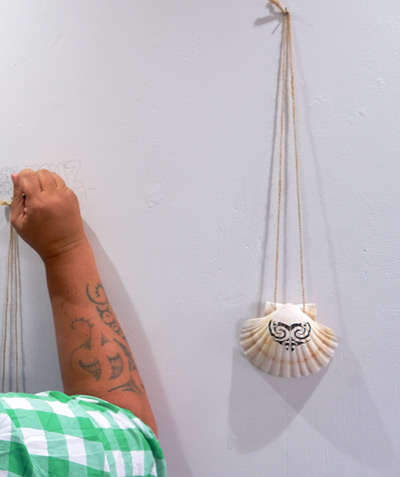
Lissy writes Nawruz’s name. Te Ara ki Rangihoua: The Way to Rangihoua (2018) by Yllwbro (NZ) and participating artists.
– a scallop shell for each person, hung at their heart-height. With accompanying text elsewhere in the gallery. Lloyd Lawrence, NYC, U.S.A (153 cm), Shaeron Caton Rose, North Yorkshire, U.K (120 cm), Nawruz Paguidopon, Manila, The Philippines (127 cm), Xiaojie Zheng, San Francisco U.S.A. / Wenzhou, China (120 cm),
Robert Hamilton, Ontario, Canada, (150 cm).
Scallop shells, brown string, moko adhesive. Care of the artists and Mokopōpaki.

E-Motion (Kinetic series #1), 2021 by Phil Dadson, a response to Colour wheel, 2021, by Pietertje van Splunter (The Hague, The Netherlands, acrylic on wood -tree ring).
Acrylic on wood, motor/Arduino module, steel stand. The E-motion series is a spin-off from the June Music concept (2019), where ratios of frequency, rhythm and colour are conjured up from imagined lines of sonic shape and form in the material world. Like a breathing mandala, this first of the E–Motion series animates this idea from the 3rd to the 4th dimension.
(With thanks to James Charlton for motor/Arduino assistance).


